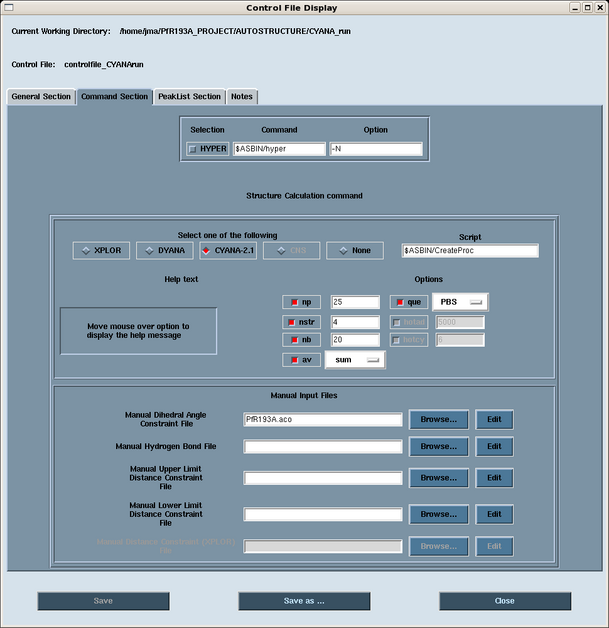CYANA Structure Calculations Using AutoStructure: Difference between revisions
(Created page with '== '''Introduction''' == Here we describe the protocol used for performing CYANA structure calculations in each cycle of AutoStructure. == '''Protocol''' == The control f…') |
No edit summary |
||
| (9 intermediate revisions by 2 users not shown) | |||
| Line 1: | Line 1: | ||
== '''Introduction''' == | == '''Introduction''' == | ||
Here we describe the protocol used for performing CYANA | Here we describe the protocol used for performing CYANA [1,2] structure calculations in each cycle of AutoStructure [3]. | ||
== '''Protocol''' == | == '''Protocol''' == | ||
The control file governs the options used in the execution of the AutoStructure run. It is recommended that the user sets these options in the control file using the AutoStructure GUI. The options are found in the Command | The control file governs the options used in the execution of the AutoStructure run. It is recommended that the user sets these options in the control file using the AutoStructure GUI. The options are found in the Command Section (Figure 1). Select the CYANA-2.1 button. The calculations are run over a cluster by a shell script called CreateProc. Typically, we compute 100 structures per cycle (i.e., 4 structures in 25 nodes), and keep the best 20 structures (lowest target function) for input into the next round of NOESYASSIGN. A queue system (i.e., PBS) is chosen for running over the cluster. Additional files in CYANA format can be added to the structure calculation in this page, including dihedral angle constraints (.aco), hydrogen bond constraints and manual upper (.upl) and lower (.lol) distance constraints. | ||
==== Figure 1: AutoStructure Control File: Command | ==== Figure 1: AutoStructure Control File: Command Section ==== | ||
[[Image: | [[Image:AScontrol CYANAcommand.png|611x628px]] | ||
<br> | |||
Here is an example AutoStructure [[Media:Controlfile_CYANArun.txt|control file]] for a CYANA run. | |||
The | == <span class="mw-headline">'''Starting a Calculation''' </span> == | ||
<pre>/farm/software/AutoStructure/AutoStructure-2.2.1/bin/autostructure -c controlfile_CYANArun -o testCYANArun.out -v</pre> | |||
The AutoStructure run is best initiated from the command line in order to perform the structure calculations in parallel. For example: | |||
<pre>/farm/software/AutoStructure/AutoStructure-2.2.1/bin/autostructure -c controlfile_CYANArun -o testCYANArun.out -v | |||
</pre> | |||
<br> | |||
== <span class="mw-headline"> '''References''' </span> == | |||
[http://www.ncbi.nlm.nih.gov/pubmed/9367762?itool=EntrezSystem2.PEntrez.Pubmed.Pubmed_ResultsPanel.Pubmed_RVDocSum&ordinalpos=2 1. Güntert, P,, Mumenthaler, C. and Wüthrich, K. (1997) Torsion angle dynamics for NMR structure calculation with the new program DYANA. ''J. Mol. Biol. 273'', 283-298.] | |||
[http://www.ncbi.nlm.nih.gov/pubmed/12051947?itool=EntrezSystem2.PEntrez.Pubmed.Pubmed_ResultsPanel.Pubmed_RVDocSum&ordinalpos=4 2. Herrmann, T., Güntert P. and Wüthrich, K. (2002) Protein NMR structure determination with automated NOE assignment using the new software CANDID and the torsion angle dynamics algorithm DYANA. ''J Mol Biol 319'', 209-227.]<br> | |||
[http://www.ncbi.nlm.nih.gov/pubmed/16374783?itool=EntrezSystem2.PEntrez.Pubmed.Pubmed_ResultsPanel.Pubmed_RVDocSum&ordinalpos=1 3. Huang, Y.J., Tejero, R., Powers, R. and Montelione, G.T. (2006) A topology-constrained distance network algorithm for protein structure determination from NOESY data, ''Proteins 62'', 587-603.] | |||
<br> <br> | |||
Latest revision as of 21:28, 6 January 2010
Introduction
Here we describe the protocol used for performing CYANA [1,2] structure calculations in each cycle of AutoStructure [3].
Protocol
The control file governs the options used in the execution of the AutoStructure run. It is recommended that the user sets these options in the control file using the AutoStructure GUI. The options are found in the Command Section (Figure 1). Select the CYANA-2.1 button. The calculations are run over a cluster by a shell script called CreateProc. Typically, we compute 100 structures per cycle (i.e., 4 structures in 25 nodes), and keep the best 20 structures (lowest target function) for input into the next round of NOESYASSIGN. A queue system (i.e., PBS) is chosen for running over the cluster. Additional files in CYANA format can be added to the structure calculation in this page, including dihedral angle constraints (.aco), hydrogen bond constraints and manual upper (.upl) and lower (.lol) distance constraints.
Figure 1: AutoStructure Control File: Command Section
Here is an example AutoStructure control file for a CYANA run.
Starting a Calculation
The AutoStructure run is best initiated from the command line in order to perform the structure calculations in parallel. For example:
/farm/software/AutoStructure/AutoStructure-2.2.1/bin/autostructure -c controlfile_CYANArun -o testCYANArun.out -v
References
